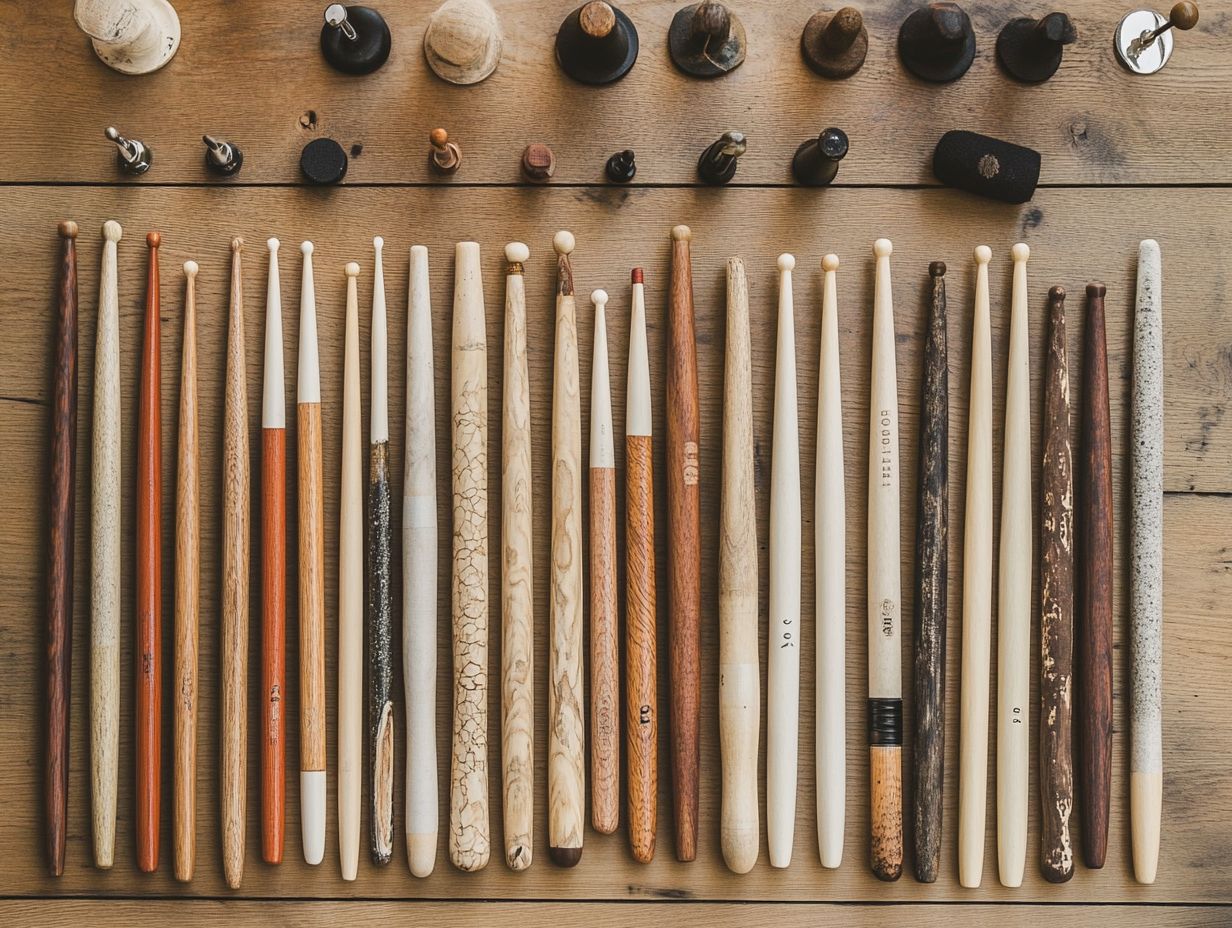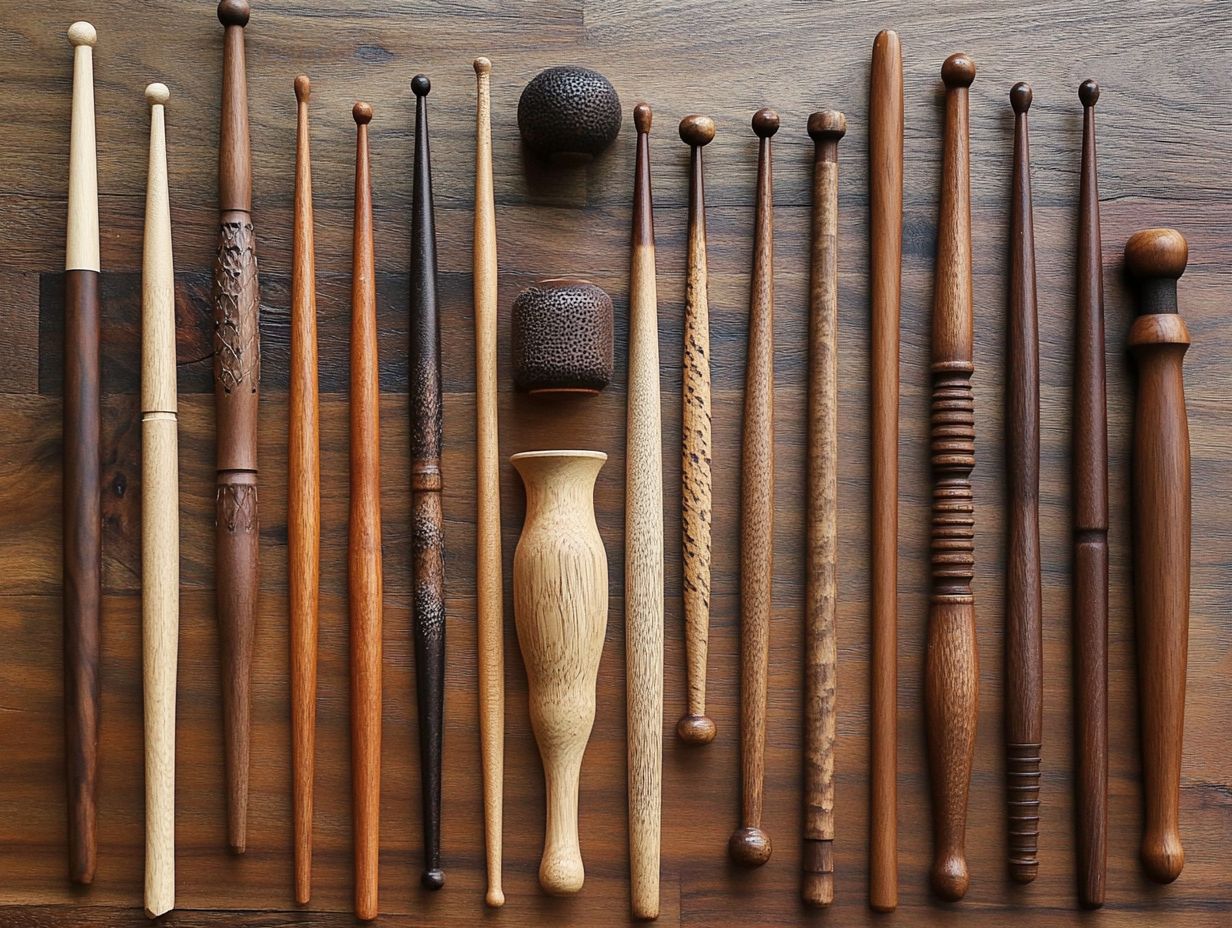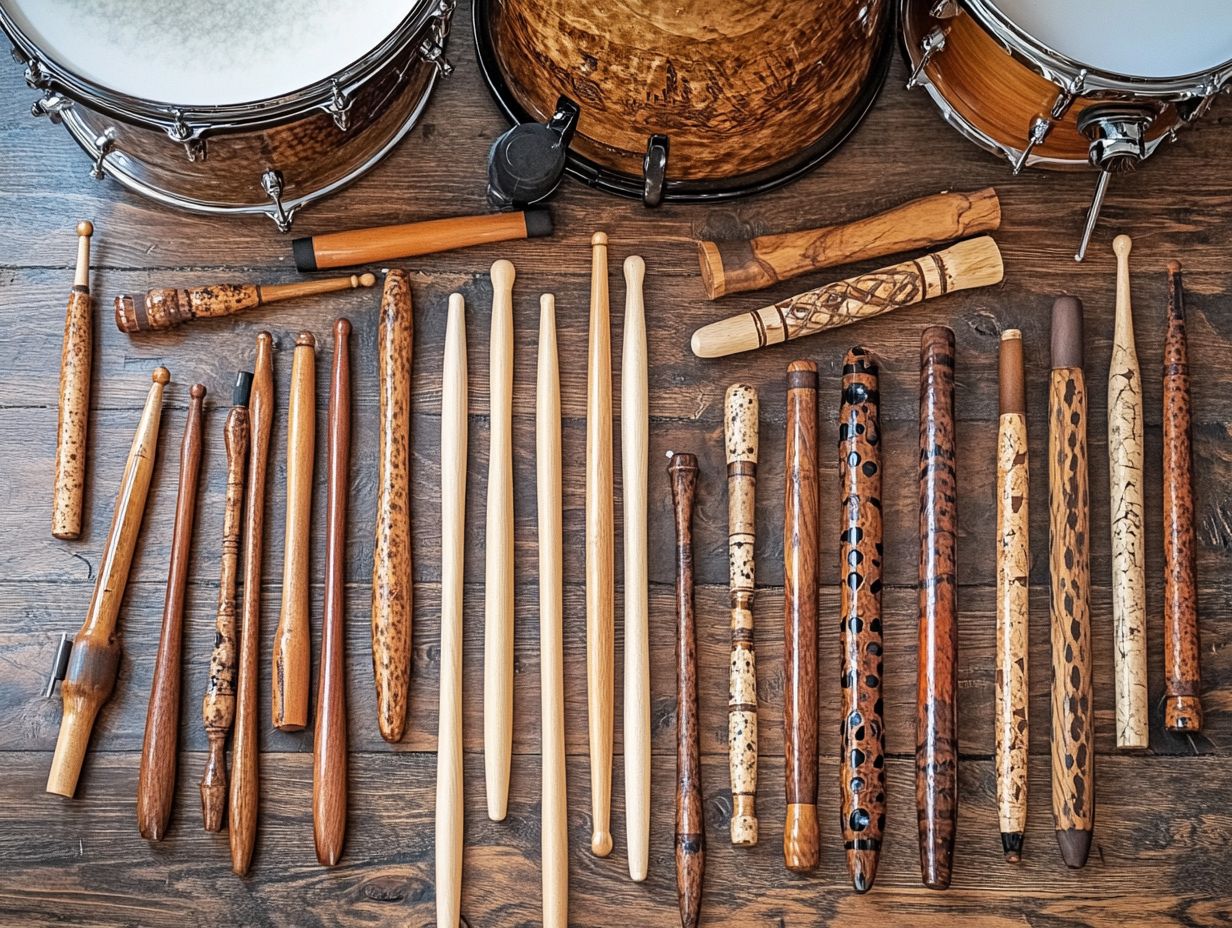Drumsticks are not merely tools; they are critical extensions of a drummer’s artistry.
Whether you are a beginner eager to explore rhythmic patterns or a seasoned musician refining your technique, comprehending the various types of drumsticks can significantly enhance your performance.
This guide will discuss the different kinds of drumsticks available, offer guidance on selecting the appropriate pair for your playing style, and present techniques tailored to each type.
Additionally, you will find recommendations for maintaining your drumsticks to ensure their longevity through numerous jam sessions. Explore this resource and discover how the right drumsticks can enrich your musical journey.
What are Drumsticks?

Drumsticks serve as essential instruments for drummers, regardless of whether they are performing on acoustic drums, electronic drums, or various drum kits. They are available in a variety of types designed to accommodate different playing styles and musical genres, including jazz, rock, and metal.
The selection of drumsticks can significantly affect sound projection, dynamics, and the overall feel of the performance. Therefore, it is imperative for drummers to comprehend the various types of drumsticks, such as those crafted from wood or featuring nylon tips, as well as important factors like weight, length, and grip texture, all of which influence their technique and comfort.
The use of diverse materials in drumstick construction enables each drummer to customize their selection to align with their personal style and the specific requirements of the music. For example, hardwood sticks typically offer a warmer tone and enhanced durability, making them particularly suitable for heavier genres such as rock and metal.
In contrast, lighter sticks may be preferred in jazz settings for their finesse and rapid response.
Additionally, specialized designs, including sticks with unique taper shapes or thicker grips, provide drummers with greater control and a range of articulations, thereby enhancing their expressive capabilities.
A thorough understanding of the intricacies associated with drumsticks give the power tos musicians to make informed decisions that have a direct impact on their artistic expression and overall performance quality.
Types of Drumsticks
A variety of drumsticks is available for drummers, each specifically designed to accommodate distinct playing styles, techniques, and musical genres.
These drumsticks offer unique characteristics in terms of weight, length, and grip, all of which significantly influence sound dynamics and overall performance quality.
Traditional drumsticks, primarily constructed from wood, are favored by many drummers due to their durability and versatility. In contrast, specialty sticks and brushes offer different tactile experiences and sound modulation options that are particularly suited for genres such as jazz, rock, and metal.
Traditional Drumsticks
Traditional drumsticks are the most widely utilized type among drummers, primarily constructed from wood and designed to provide a balanced feel and dependable durability. This makes them suitable for a variety of musical styles, including rock, jazz, and metal.
The dimensions of traditional drumsticks, including their weight and length, significantly influence the rebound, control, and sound produced on drums, enabling drummers to execute various techniques and dynamics during performances.
The selection of wood, such as hickory, maple, or birch, further defines the characteristics of these percussion instruments. Hickory is recognized for its resilience and shock absorption, while maple is lighter and produces a brighter sound.
Weights typically range from 1.5 to 2.5 ounces, and lengths can vary from 16 to 17 inches, allowing players to choose sticks that best complement their individual playing style. Lighter sticks can enhance speed and finesse, making them ideal for intricate jazz rhythms, whereas heavier options facilitate the powerful strokes required in metal genres, thereby creating a rich tapestry of sound that enhances live performances.
Rods and Brushes
Rods and brushes represent alternative types of drumsticks that offer drummers distinct sound modulation capabilities, making them particularly favored in softer musical genres such as jazz, where sensitivity and dynamics are essential.
These implements differ from traditional drumsticks in both design and material composition; rods are typically constructed from bundles of thin dowels, providing a lighter touch, while brushes are generally made with wire or nylon bristles, producing a softer and more delicate sound on drum surfaces.
This softer approach enables nuanced performances, allowing drummers to create subtle accents and varied textures that enrich their rhythms. Plus jazz, these tools are also utilized in genres such as folk and acoustic music, where a gentler playing style is often preferred.
Drummers who choose rods and brushes have the ability to manipulate the intensity of their playing, achieving a wide range of dynamics that enhance expressiveness. Whether establishing delicate grooves or increasing intensity during a solo, the versatility of rods and brushes promotes a personalized touch, encouraging musicians to explore the emotional depths of their art.
Specialty Drumsticks
Specialty drumsticks encompass a diverse range of products that are specifically designed for particular drumming applications or to accommodate the preferences of individual drummers. This includes signature models created by renowned artists, which aim to enhance their distinctive playing styles and techniques. These drumsticks frequently incorporate unique designs, materials, and ergonomic features that contribute to performance quality, thereby allowing for increased versatility and responsiveness across various musical contexts.
Drummers can select from ergonomic designs that emphasize comfort and minimize fatigue, enabling them to perform for extended periods without discomfort. Additionally, customization options permit musicians to personalize their sticks according to their individual preferences, whether related to weight, length, or finish.
Such thoughtful design not only enhances a drummer’s confidence in their instrument but also directly impacts their overall sound, offering a more nuanced approach to rhythm and dynamics. With these advancements, it is clear that specialty drumsticks can significantly improve a drummer’s experience, effectively catering to their individual needs in both stage and studio environments.
Choosing the Right Drumsticks for Your Playing Style

Selecting the appropriate drumsticks for one’s playing style is essential for achieving optimal performance. The weight, length, and grip of the drumsticks significantly influence comfort, control, and overall sound.
Factors such as the intended musical genre—whether jazz, rock, or metal—as well as individual preferences concerning stick thickness, balance point, and grip texture, are critical considerations in the selection process. Careful attention to these elements will undoubtedly enhance the overall drumming experience.
Factors to Consider
When selecting drumsticks, several factors must be taken into account, including stick weight, length, grip texture, and balance, as these elements directly influence a drummer’s technique and comfort during performance.
The weight of the sticks can significantly affect the power and intensity of each stroke, thereby impacting how a drummer interacts with their instruments across various musical genres. For example, lighter sticks may facilitate faster and more intricate playing in jazz, whereas heavier sticks provide the necessary force for rock and metal drumming, enabling more pronounced backbeats.
Stick length is also a critical consideration; longer sticks can offer increased reach and leverage, which is particularly advantageous in orchestral settings, while shorter sticks may allow for greater maneuverability and finesse in smaller venues.
Furthermore, the grip texture is essential for ensuring comfort and minimizing slippage, which is crucial for maintaining rhythm during dynamic performances.
Lastly, the balance of the stick affects its feel in the hand, significantly impacting articulation and responsiveness as drummers transition between different playing styles.
Matching Drumsticks to Genre and Technique
Matching drumsticks to specific genres and techniques is crucial for drummers aiming to achieve the desired sound and performance quality. Different musical styles necessitate distinct approaches to grip, dynamics, and stick design.
For example, heavier drumsticks are often preferred in rock and metal genres due to their volume and projection capabilities, while lighter sticks are suitable for jazz, as they allow for greater finesse and sensitivity in expressive playing.
In genres such as funk or R&B, drummers typically choose sticks that facilitate intricate rhythms and ghost notes, often selecting models with a thinner diameter to ensure precise articulation.
Similarly, in orchestral settings, a broader tip may be favored to produce a fuller, richer tone on the drums, thus ensuring clarity during performances.
This thoughtful selection of stick characteristics not only enhances the drumming experience but also fosters musical expression across various genres, demonstrating the drummer’s versatility and adaptability in employing the appropriate tools for each performance.
Techniques for Different Drumstick Types
Different types of drumsticks necessitate specific techniques for optimal utilization, as various grips and motions significantly influence sound production, control, and overall performance.
A comprehensive understanding of the nuances associated with traditional grip, matched grip, and specialized techniques for mallets or rods can enhance a drummer’s ability to execute complex rhythms and dynamic variations across a wide array of musical genres.
Traditional Grip
The traditional grip is a widely recognized technique among drummers, particularly in the jazz genre, where the left hand holds the stick differently than the right. This distinct grip allows for unique wrist motion and enhanced sensitivity.
As a result, it facilitates a greater control over dynamics and overall feel, enabling drummers to execute rudiments and improvisational patterns with both precision and fluidity.
Rooted in the early traditions of marching band drumming, the traditional grip has evolved into a fundamental technique across various musical styles. Drummers often find that this approach enhances their ability to perform soft, intricate patterns while providing a broader dynamic range, which significantly influences how sound projects within different musical contexts.
Furthermore, by employing the traditional grip, musicians can achieve a level of expressiveness that proves particularly advantageous in genres such as jazz and blues, where subtlety and nuance play critical roles.
Mastering this grip allows drummers to develop greater hand independence and fluid playing styles, making it an integral component of their overall technique.
Matched Grip

Matched grip is a technique in which both hands hold the drumsticks in the same manner, promoting consistency and balance that are essential for achieving uniform sound production across various drum types. This grip facilitates enhanced finger dexterity and control, making it a preferred choice among drummers in genres such as rock and metal, where power and precision are critical.
By fostering symmetry in hand movement, matched grip not only provides a solid foundation for striking the drumsticks but also contributes to reducing fatigue during extended playing sessions. Drummers employing this technique can attain a greater range of dynamics due to the uniform distribution of weight and force.
This stands in contrast to other grips, such as traditional grip, which may require one hand to adopt a different position, potentially leading to inconsistencies.
The versatility of matched grip makes it especially valuable for individuals seeking to enhance their overall technique and maintain a competitive edge in performances, thereby ensuring that each hit resonates with precision and clarity.
French Grip
The French grip is characterized by holding the stick primarily with the fingers, which allows for increased wrist flexibility and facilitates rapid motion and intricate drumming patterns.
This technique is often preferred in orchestral settings and advanced drumming contexts, as it enhances a drummer’s capacity to execute dynamic changes and expressiveness effectively.
The defining feature of this grip lies in its promotion of natural motion that emphasizes finesse over sheer force, distinguishing it from other techniques such as the matched grip, which tends to rely more on the forearm.
Drummers who utilize the French grip can achieve faster and more fluid strokes, which aids in executing complex rhythms and subtle accents. This grip fosters a heightened level of sensitivity, give the power toing performers to convey a wide range of emotions through their music.
Therefore, the French grip not only enhances speed but also encourages greater creative expression, making it a highly desirable technique for individuals seeking to elevate their drumming artistry.
Mallet Techniques
Mallet techniques are primarily utilized with specialty drumsticks designed for softer playing styles and sound modulation. These techniques provide drummers with the capability to create nuanced tones and dynamics on their instruments.
The grip employed with mallets is essential for achieving optimal resonance and articulation, facilitating expressive performance in genres such as jazz and orchestral music.
A proper grip enables drummers to maintain control of the mallets, allowing them to produce a diverse range of sounds, from gentle taps to more vigorous strikes. By experimenting with varying grip pressure and hand positioning, musicians can uncover a spectrum of timbres that evoke specific emotional responses from the audience.
The angle at which mallets are held can significantly impact the quality of sound produced; a slight tilt may enhance certain harmonics, enriching the overall performance. Mastery of these techniques improves the musician’s ability to convey subtle moods and dynamics, making their interpretations not only audible but also profoundly impactful.
Caring for and Maintaining Drumsticks
Proper care and maintenance of drumsticks are essential for ensuring their durability and longevity, which enables drummers to sustain optimal performance levels during both practice sessions and live performances.
Regular inspections for wear, appropriate storage in a protective bag, and careful avoidance of excessive humidity can substantially extend the lifespan of the drumsticks, thereby preserving their sound quality and playability.
Tips for Prolonging the Lifespan of Your Drumsticks
To extend the lifespan of drumsticks, it is advisable to implement several maintenance strategies. These include avoiding contact with hard surfaces, ensuring proper storage, and regularly rotating drumsticks during practice sessions.
Such care measures can prevent premature wear and tear, thereby ensuring that drumsticks remain durable and effective throughout one’s drumming journey.
Plus these practices, it is essential to develop a habit of inspecting drumsticks for signs of damage, such as splinters or cracks, which can adversely affect the playing experience. Drumsticks should always be stored in a protective case to minimize exposure to moisture and temperature extremes, which can weaken the wood.
During practice, alternating between different pairs of drumsticks can help distribute wear evenly and maximize their lifespan. By incorporating these habits into their routine, drummers can not only enhance the longevity of their drumsticks but also improve their overall performance quality, resulting in a more satisfying playing experience.
Frequently Asked Questions

What are the different playing styles for drumsticks?
The different playing styles for drumsticks include traditional grip, matched grip, and French grip.
What type of drumsticks should I use for heavy hitting?
If you tend to hit the drums hard, you may want to opt for thicker and heavier drumsticks, such as 2B or 5B. These will provide more power and durability.
Which drumsticks are best for speed and agility?
For speed and agility, lighter and thinner drumsticks, such as 7A or 5A, are recommended. These allow for quicker movements and easier control.
Are there specific drumsticks for jazz music?
Yes, jazz drummers typically use thinner and lighter drumsticks, such as 7A or 8D, for a more delicate and subtle sound.
Can I use the same drumsticks for both drum set and marching band?
While you can certainly use the same drumsticks for both, it is recommended to use different sticks for marching band and drum set. For marching band, thicker and heavier sticks, such as 2B or 5B, are often used for louder projection and durability.
Are there any drumsticks specifically designed for electronic drums?
Yes, there are some drumsticks specifically designed for electronic drums. These sticks often have rubber tips to prevent damage to the electronic drum pads.


 Unleash Heavy Metal Riffs with the Best Bass Guitars: A Comprehensive Guide
Unleash Heavy Metal Riffs with the Best Bass Guitars: A Comprehensive Guide